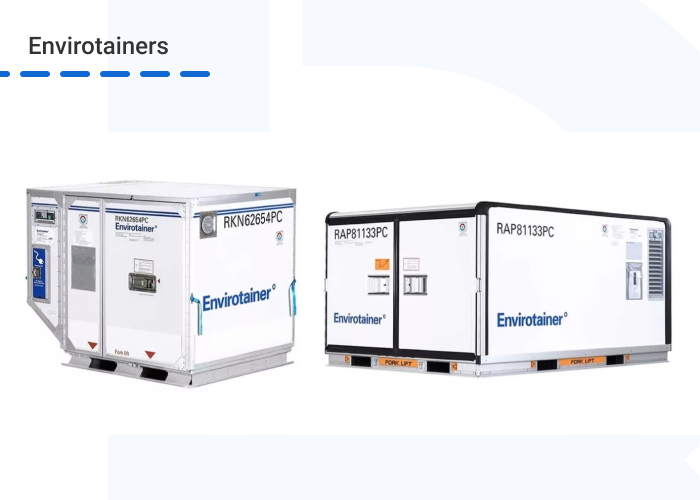What is a Cold Chain Warehouse?
Cold Storage Warehouse Examples
The Main Challenges of Cold-Chain Logistics
The Key Role of WMS Software in Cold-Chain Logistics
How HQSoftware Can Help With a WMS System for Your Cold Chain Warehouse
Supply chains are evolving to meet growing consumer demand, with the cold chain industry playing a crucial role. The number of different temperature-sensitive products is increasing. As a result, the importance of specialized cold storage solutions is becoming more and more evident.
One such solution, critical to many industries, is the cold storage warehouse. This article focuses on the world of cold storage, explaining what it is, its importance, and its unique features. We will also explore the best practices and challenges of cold chain warehouse management, emphasizing the role of warehouse management system development in optimizing operations.
A study by Grand View Research projects that the global cold chain market will generate $628 billion in revenue by 2028, with a compound annual growth rate (CAGR) of 14.8% until then. These projections highlight the rapid expansion and growing significance of the global cold chain market, driven by increasing demand for temperature-sensitive products and cold storage services.
Cold chain warehouses, also known as cold storage warehouses, provide storage of goods at low temperatures to preserve their quality. Thanks to these procedures, they don’t lose the desired taste, color and smell. When goods are stored in such warehouses, a high degree of safety is maintained, the risk of spoilage is reduced, and food can be safely consumed. Shelf life is increased and the costs associated with natural waste are reduced.
Traditionally, cold storage warehousing is used for cooling dairy products, meat and vegetables, as well as medicines and some cosmetics. The fish, meat, and seafood segment dominated the global market in 2023 with a market share of 41.3%.
Depending on the temperature maintained in them, cold chain warehouses are divided into two types:
1) Chilled storage facilities, or chill stores, typically maintain temperatures between 2 and 8 degrees Celsius and prevent cold loss. They are mainly used to store fresh vegetables, dairy products and other perishable goods that need to be kept cool but not frozen.
2) Frozen storage facilities operate in sub-zero temperatures, usually between -18 and -25 degrees Celsius. They store frozen foods such as meat, seafood and frozen products that need to be kept at low temperatures to prevent bacterial growth and preserve their quality.
Need a custom software solution? We’re ready to help!HQSoftware has a team of skilled professionals ready to tackle the project. Ask me!
Natallia Rudzik
Business Development Manager
Cold storage is a complex process involving several interrelated components. Let’s look at the key elements that make up an efficient cold storage system:
A сooling storage facility is a structure equipped with technology designed to preserve the appearance and taste of perishable products. Special materials and insulation are used in constructing these warehouses to maintain a constant internal temperature.
Inside warehouses, there are often ramps that speed up and simplify the loading/unloading of products. Moreover, the entire interior space is zoned, i.e. the room is divided into separate cold rooms and additional rooms, each of which has its own specific purpose.
Modern cooling storage facilities often use energy-efficient technologies such as variable frequency drives and smart control systems to optimize energy consumption. Some facilities are also using alternative cooling methods, such as CO2 or ammonia-based systems, to reduce environmental impact.
Proper packaging plays a key role in cold chain logistics. Products must be packaged in materials that can withstand low temperatures and protect against moisture, condensation and temperature fluctuations. Common types of packaging include:
The choice of packaging is determined by factors such as the temperature requirements of the product, the duration of transportation, and external conditions. For example, pharmaceutical products may require specialized packaging with temperature control devices to meet strict regulatory standards.

The transportation of goods in the cold chain requires specially designed vehicles equipped with refrigeration units. These vehicles, often referred to as refrigerated trucks or refrigerated containers, maintain the cold chain during transportation. Advanced temperature control systems and real-time monitoring devices ensure that the temperature set point is maintained throughout the journey. For example, fresh seafood transportation uses reefers (refrigerated trailers) with integrated temperature sensors to monitor the condition of the cargo in real time.
When it comes to transporting pharmaceuticals, va-Q-tainers and envirotainers are often used. Va-Q-tainer is an advanced passive container, perfect for global transportation. It is best suited for situations where long-term passive temperature control without external power is required. Va-Q-tainers provide high thermal efficiency thanks to advanced insulation materials.

Envirotainer is the best option for shipments requiring precise and active temperature control with real-time monitoring. It is suitable for environments with significant temperature fluctuations and for expensive, sensitive pharmaceuticals.
Many goods are delivered via Intermodal transportation, which involves multiple modes such as trucks, ships and airplanes and poses unique challenges to maintaining the cold chain. The seamless transfer of cargo between different modes of transportation is critical to prevent temperature deviations. For example, transporting vaccines from the manufacturer to medical facilities utilizes both air and ground refrigerated trucks to ensure that strict temperature standards are maintained every step of the way.

Modern cold chain logistics relies heavily on shipping and tracking technologies. GPS-enabled devices and Internet of Things (IoT) sensors provide real-time location and temperature data. This allows logistics managers to monitor shipments remotely. This level of visibility allows for a quick response to any deviations from the temperature setpoint. Advanced tracking systems also help optimize delivery routes and schedules, reducing the time products spend in transit and minimizing the risk of temperature deviations.
Some systems can even predict potential problems based on historical data and current conditions, allowing you to proactively address issues. For example, analyzing data on past delays at customs can be useful in developing alternative routes to avoid similar situations in the future.
Effective customs clearance is critical to maintaining the integrity of temperature-sensitive products in international transportation. Delays at borders can lead to long periods of time outside the controlled environment, negatively impacting product quality.
Cold chain logistics providers often work closely with customs authorities to simplify the customs clearance process for temperature-sensitive goods. This may include pre-clearing shipments, using special routes for perishable products, or employing customs brokers who specialize in cold chain logistics. For example, DHL uses specialized customs routes for perishables, which significantly reduces border crossing times and ensures the safety of the shipment.
The scope of application of cold storage facilities covers various industries. However, the most prominent sectors are the food and pharmaceutical industries. Let’s take a closer look at those.
The term “cold chain” originated in the pharmaceutical industry and referred to regulating the rules of storage of pharmaceuticals, mainly immunobiological products. But recently, the concept of “cold chain” is increasingly common in the logistics of perishable food products — meat, milk, fish, eggs and other products that require special temperature conditions during storage and transportation.
Cold storage warehouses ensure that perishable products remain fresh and safe. Each product category has different temperature requirements. For example, fresh produce typically requires temperatures between 0 and 13°C, while frozen foods must be stored at -18°C or below.
Cold stores in the food industry often have several temperature zones for different types of products. They can also be equipped with ripening chambers for fruits such as bananas and avocados, which allows the ripening process to be precisely controlled.
In recent years, significant advances have been made in the field of pharmaceuticals, allowing the development of life-saving drugs, vaccines and biologics. Many of these products are very sensitive to temperature fluctuations, and any deviation from the recommended range can make them ineffective or even harmful. This is where the cold chain comes to the rescue. It covers the entire process, from the production of medicines, their storage, transportation, distribution, and delivery to the end user.
Cold storage pharmaceutical warehouses must meet strict regulatory standards, such as Good Distribution Practice (GDP) regulations. These facilities often utilize redundant cooling systems, backup power generators, and advanced monitoring equipment to ensure that temperatures are constantly monitored.
Temperature ranges in pharmaceutical cold storage facilities can vary from standard cold storage (2-8°C) to ultra-low-temperature freezers (-80°C) for storing some vaccines and biotech products. Some facilities are also equipped with cryogenic storage for cell therapy and other advanced medical products, where temperatures can reach -196°C.

Even though cold chain logistics has advanced significantly in recent years, it still faces several challenges:
Temperature monitoring: Any disturbance in the cold chain, even a short-term one, can jeopardize product quality and safety. Therefore, continuous temperature monitoring throughout the supply chain is essential to quickly identify and correct any abnormalities. Modern monitoring systems such as temperature data loggers and IoT-enabled devices are used for this purpose. They help to monitor the situation in real time and alert you to any temperature fluctuations. However, implementing such advanced monitoring systems across the entire cold chain can be complex and costly.
Infrastructure and equipment: A variety of equipment is needed to maintain the cold chain. For example, isothermal vans, railcars, ice trucks, refrigerated railcars, specialized warehouses, etc. Often, the more complex and longer the cold chain is, the more equipment is required for its operation. All these facilities must be properly tested and equipped with backup power supplies to avoid malfunctions during power outages.
Energy consumption: Maintaining constant low temperatures requires substantial energy, leading to high operational costs and environmental concerns.
Regulatory compliance: Compliance with regulatory requirements such as Good Distribution Practice (GDP) and Good Manufacturing Practice (GMP) is vital for pharmaceutical manufacturers, distributors and logistics service providers. Non-compliance can lead to negative consequences such as regulatory fines, product recalls and damage to a company’s reputation.
Transportation risks: Shipping temperature-sensitive products around the world involves a variety of environmental conditions, including extreme temperatures during transportation. Effective packaging, insulation and cold chain logistics strategies are critical to mitigate transportation risks and ensure product integrity.
Skilled workforce: Employees who work in cold storage warehouses must have specialized knowledge of how to handle temperature-sensitive products. They must also be able to operate specialized equipment and follow strict safety protocols. This means that new employees must undergo additional training when they join the organization. This makes recruitment and retention a major challenge.
In summary, the WMS must be able to track things that are not required in a conventional warehouse (e.g. temperature fluctuations), apply optimizations that are less relevant in a conventional warehouse, and integrate with equipment specific to cold storage. All of this increases the demands on the WMS provider, but it also places additional responsibility on the customer to think through the processes.
Need a custom software solution? We’re ready to help!HQSoftware has a team of skilled professionals ready to tackle the project. Ask me!
Natallia Rudzik
Business Development Manager
The main goal of efficient and well-designed WMS software is to optimize all aspects of warehouse management, from receiving and storing incoming goods to shipping. In cold-chain logistics, it ensures that products are stored and transported under the right conditions, provides real-time visibility of stored products, and guarantees full traceability of all movements of goods. It also optimizes storage space and reduces the operating costs of the various logistics flows.
Keeping the cold chain intact: One of the main goals for supply chain operators and logistics professionals is to keep the cold chain intact. WMS software plays a key role in preventing the risk of cold chain disruption by constantly monitoring temperatures, alerting for any deviations, and taking appropriate actions.
Ensuring real-time traceability: The WMS system keeps a documented record of all logistics flows and maintains full traceability of all tasks performed in the warehouse. Since it tracks and stores all lot numbers from receipt to shipment, this feature is particularly useful and important for lot recalls.
Managing expiration dates: In temperature-controlled warehouses, a WMS is invaluable for tracking expiration dates of perishable goods and issuing alerts when those dates are exceeded.
Transportation management: WMS software helps cold chain logistics operators keep their costs under control and reduce their environmental impact. Using advanced algorithms, it compares carrier prices, optimizes load grouping and maximizes truck occupancy. At a time of rising energy prices, this feature helps reduce transportation costs.
Zone management: WMS software is essential for zone management, which involves optimizing storage areas for temperature requirements and product compatibility. This ensures that goods are stored in the right conditions, which improves product quality and safety. In addition, zone management improves warehouse efficiency by organizing goods in a way that simplifies access and minimizes handling time.
Picking strategies: The picking process is the most time-consuming operation in the warehouse. It involves searching and retrieving goods from storage cells in order to fulfill a customer order. WMS software helps to choose the most efficient picking methods (batch picking, wave picking, or zone picking) and speed up the process. The benefits of implementing optimized picking strategies include reduced labor costs and fewer errors.
Demand forecasting: WMS software assists in planning and pre-estimating demand for goods and materials, allowing companies to maintain maximum profitability. Companies that lack accurate demand forecasting that takes into account customer needs, preferences and intentions risk missing out on additional sales opportunities.
For many years now, HQSoftware has specialized in developing custom software solutions in WMS. We have worked with customers from various parts of the world, with different requests and budgets. Our extensive experience can play a decisive role in optimizing cold chain warehouse management through developing a customized warehouse management system.
Our team is able to create an efficient WMS that meets the unique challenges of cold storage warehouses. Our customized solutions can include real-time temperature monitoring, automatic alerts in the event of temperature deviations, and predictive maintenance features to ensure optimal storage conditions.
The HQSoftware team can develop a WMS that not only improves operational efficiency but also ensures regulatory compliance in the demanding cold chain industry. It should be noted that in developing such systems, we always focus on user-friendly interfaces and scalable architecture.
By partnering with us, warehouse and cold storage facility operators can gain a competitive advantage by ensuring real-time traceability, better transportation management, and reduced costs.
If you have any questions or think you might like to cooperate with us on your project, please contact us. We will be happy to discuss your requirements and work with you to implement them.

HQSoftware Founder
Having founded the company in 2001, uses his broad knowledge to drive the company forward. Ready to share his wisdom on software development and technology insights